30+ Fun Phonics Activities for Kindergarten: Games, Ideas, and Worksheets
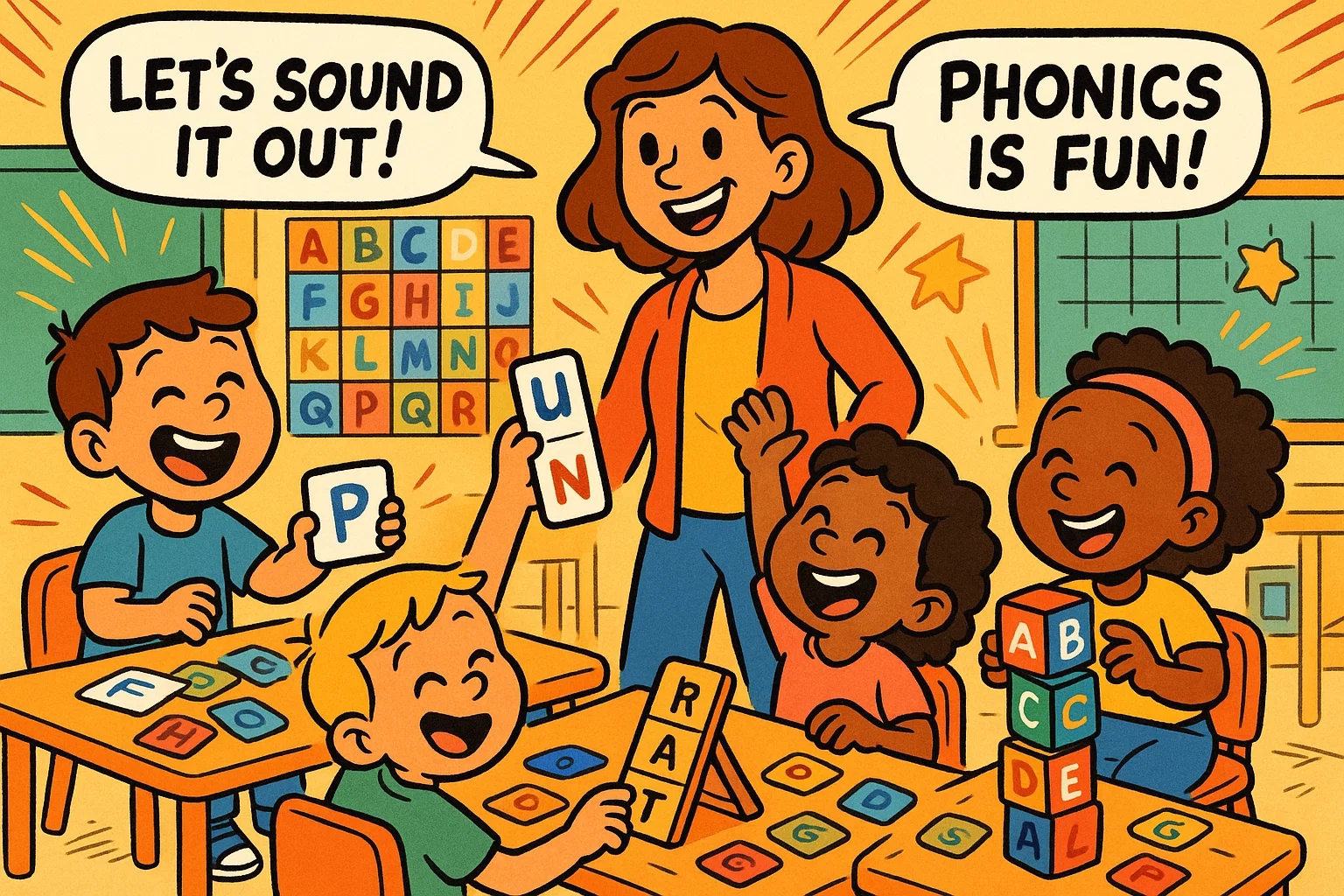
Learning to read is a major milestone, and at its core lies phonics — understanding the predictable relationship between letters and sounds. For young students in kindergarten and first grade, making these abstract connections fun is the key to success. Fun phonics activities turn alphabet learning and sound recognition into engaging games, building a strong foundation for literacy and decoding.
This guide includes over 30 proven, multi-sensory phonics activities and games for classroom and home practice. We’ve organized ideas by learning style—from hands-on phonics activities using household items to structured printable phonics worksheets and engaging online phonics games. It covers everything from CVC words (consonant-vowel-consonant) to challenging digraphs and vowel teams, empowering you to effectively teach phonics and help students become confident readers and writers.
Hands-On Phonics Activities for Kindergarten
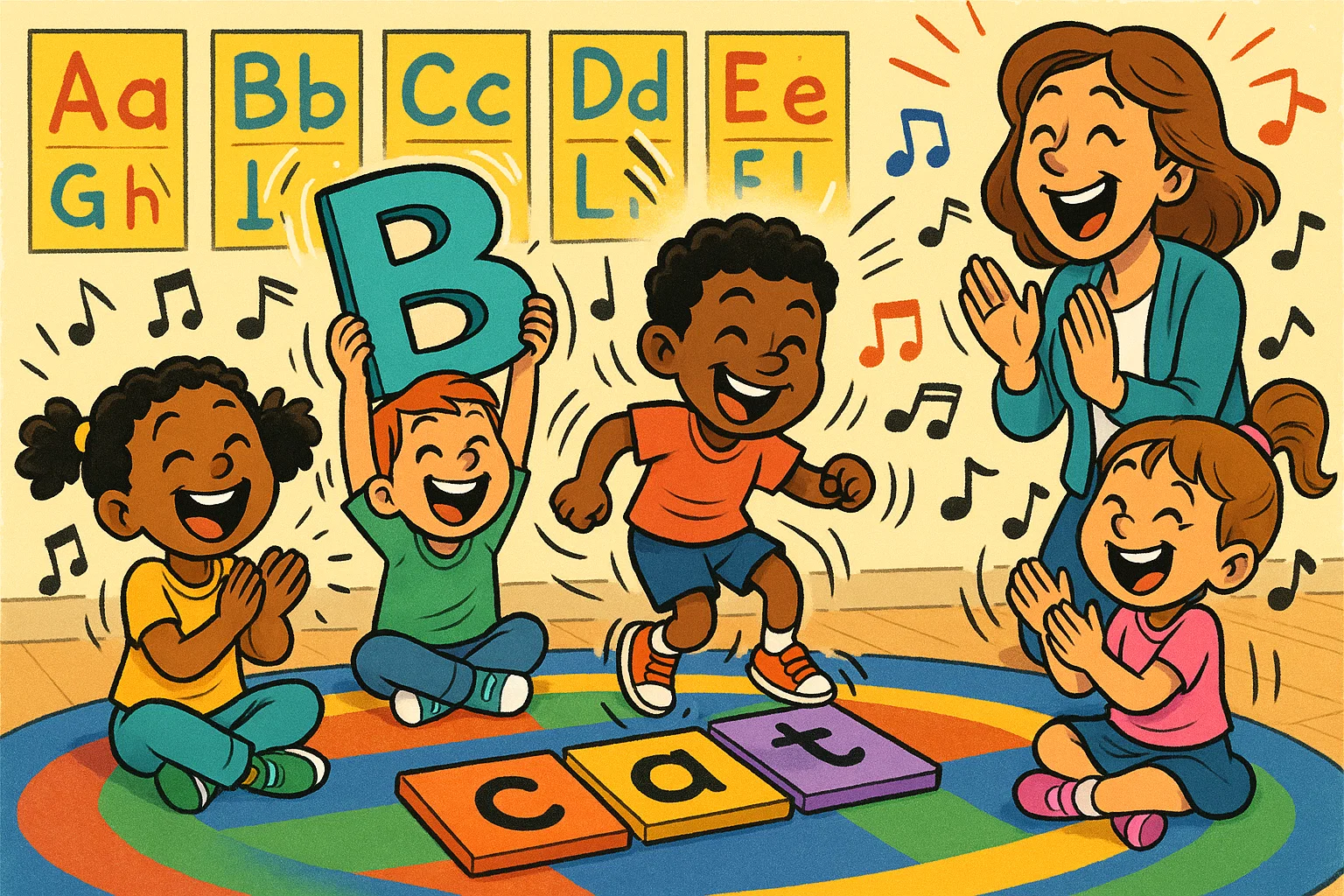
For kindergarteners, active learning is essential! These hands-on phonics activities use movement, crafts, and sensory input to make abstract letters and sounds concrete. They are low-prep, making them perfect for busy teachers and parents seeking easy phonics engagement.
Core Skills Targeted by Hands-On Play
| Phonics Skill | Description | Key Learning Outcome |
| Beginning Sounds | Matching the first sound of a word to its letter. | Develops phonemic awareness. |
| CVC Word Blending | Pushing sounds together to read the word (e.g., /c/ /a/ /t/). | Core decoding skill. |
| Vowel Sound Isolation | Identifying and distinguishing between short vowels. | Crucial for spelling patterns and decodable text. |
| Digraph Recognition | Recognizing two letters that make one sound (e.g., ‘sh’, ‘ch’). | Expands reading and spelling ability. |
Letter Sound Games Using Everyday Items
You don’t need expensive phonics resources! Your home or classroom is already filled with tools for fun phonics practice.
- “Stack the Sound” Cups: Write a single letter (consonant or vowel) on the bottom of several disposable cups. Provide small picture cards or miniature objects. The child must say the item’s name, isolate the beginning sound, and stack the item on the cup labeled with the correct initial letter. This reinforces the crucial letter-sound connection.
- Spoon/Sticker Match: Place a small sticker (e.g., a sticky note piece) labeled with a high-frequency word or CVC word onto the end of plastic spoons. Write the same words on a large piece of paper. The child “scoops” the correct matching word with the spoon, saying the word aloud each time. This is a great way to practice early word recognition.
Word Walk and Sound Hopscotch
Gross motor movement significantly boosts memory retention. Physical movement helps reinforce phonics skills.
- Word Walk: Use sidewalk chalk to write large decodable CVC words on the ground (e.g., map, fog, bus). The child walks heel-to-toe along the word, saying each individual letter sound as their foot touches it, and then runs to the end to blend and read the word. This physically segments the word, making the abstract sounds concrete.
- Sound Hopscotch: Draw a hopscotch grid. Instead of numbers, write letters, digraphs (‘th,’ ‘sh’), or vowel teams (‘ee,’ ‘oa’) in the squares. Call out a sound, and the child must hop to the correct square, say the letter name, and a word that uses that sound. These activities are a great way to combine physical play with literacy lessons.
Swat the Letter Sounds
This highly engaging, low-prep game works for any targeted phonics patterns. It’s wonderful for building speed and automaticity.
- Prep: Write a mixture of individual letters (focusing on the new letter sounds you are teaching), digraphs, or high-frequency words on index cards or sticky notes. Tape them to a wall or lay them on the floor.
- Play: Give the child a clean fly swatter.
- Instruction: Call out a sound (e.g., “/s/ sound”) or a word (e.g., “Swat the word ‘is'”).
- Action: The child quickly finds and “swats” the correct card. The swift action and clear target make this one of the favorite phonics activities in the classroom for quick recall.
Phonics Cubes and Building Blocks
This hands-on method helps children understand how letters stack and change to make a new word.
- Build-a-Word: Write one letter on each side of six-sided blocks (use different colors for consonants and vowels). Challenge children to align three blocks to form a CVC word. Expert Tip: Start by having the child build a known word (can). Then, challenge them to change only the first block to make a new word (man). This is a foundational step in understanding spelling patterns and phonemic awareness.
Pool Noodle Word Builders
Create a versatile, durable, and fun phonics manipulative!
- Prep: Slice an old pool noodle into thin, coin-like pieces. Write individual letters on the flat sides of the pieces. Ensure you have multiples of common vowels and consonants.
- Assembly: Use a pipe cleaner or string to thread a small group of the pieces together to create a word-building tool.
- Practice: Children slide the letters to form words. They can quickly swap the beginning letter to practice blending and segmenting. This tactile process makes learning the relationship between letters and sounds tangible.
Easy Phonics Activities for Home Learning
Simple, free phonics activities can easily fit into a busy day at home. These ideas require minimal materials and provide effective fun phonics practice.
I Spy Sound Game
Adapt the classic car game into a powerful tool for isolating beginning sounds.
- The Change: Instead of describing color, describe the sound. “I spy with my little eye something that starts with the /k/ sound.” (e.g., car or cup).
- Progression: Once children master beginning sounds, you can progress to ending sounds: “I spy something that ends with the /t/ sound.” This makes it an effective activity for ongoing skill development.
Sound Sorting with Pictures
Use pictures from junk mail, magazines, or simple drawings to practice auditory discrimination.
- Gather: Select three distinct sounds (e.g., /s/, /m/, /f/).
- Label: Label three baskets, containers, or simply circles on a sheet of paper with the corresponding letter.
- Sort: The child names each picture card and listens carefully to the beginning sound, then sorts it into the correct bin. For second graders, pictures can be used for sorting by vowel team or digraph.
Flip the Pancake
A fun, active adaptation of flashcard review that kids love!
- Prep: Write a mix of CVC words and high-frequency words on paper circles cut from brown construction paper (your “pancakes”).
- Play: Lay the pancakes face down on a frying pan. Call out a word.
- Action: The child must use a spatula to flip the correct pancake, read the word aloud, and then set it aside. This activity helps develop word recognition and fluency.
Popsicle Stick Word Builders
Use craft sticks for quick, focused read and spell practice.
- Write initial consonants on individual sticks.
- Write common vowel and final consonant patterns (word families) on other sticks (e.g., ‘-an’, ‘-ig’, ‘-op’).
- The child selects a consonant stick and a word family stick and places them together to make a new word that they must blend and read aloud. This effectively teaches how spelling patterns create word families.
Magazine Scavenger Hunt
This hands-on task boosts visual recognition of letters and sounds in print.
- Target: Pick a new letter or a target sound (like the short /e/ vowel sound).
- Hunt: Give the child an old magazine, newspaper, or flyer.
- Task: The child hunts for pictures of things that start with that sound or cuts out instances of the actual letter. Gluing the findings onto a poster transforms it into a personalized Anchor Chart—a visual reminder of the new skill.
Printable Phonics Worksheets and CVC Word Activities
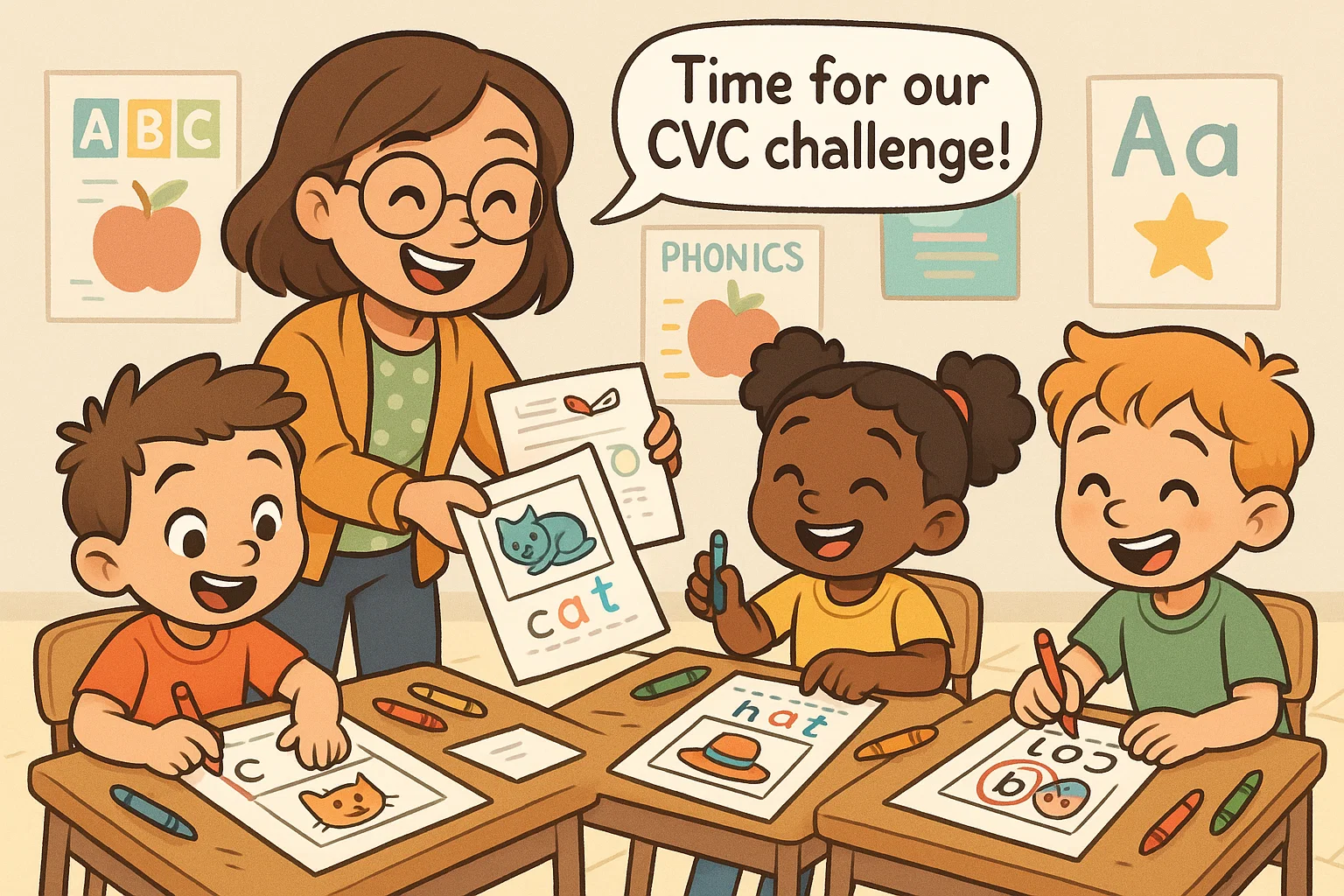
While play is vital, structured phonics practice solidifies skills. These worksheets and printables are perfect for phonics centers or homework.
Free CVC Word Worksheet Bundle
This resource reinforces one of the most essential phonics skills: blending three sounds.
- What’s Inside: Our bundle includes varied activities—from “trace and match” for visual motor skills to “find the vowel sound” for auditory practice. It systematically covers all five short vowels, which is key for early decodable reading.
- Download the free phonics activities and CVC Word Worksheet Bundle to start your practice instantly.
Color by Sound Worksheets
These highly engaging printables are a step up from simple coloring pages.
- Process: Each section of the image is labeled with a picture (e.g., fish, dog, sun). The child identifies the beginning sound of the picture and then colors the section based on a key (e.g., S=Blue, F=Red). The reward is the fully revealed, colorful picture, which adds a gamified element to structured practice.
Missing Letter Puzzles
These fill-in-the-blank activities require students to use their knowledge of vowel sounds and consonants to complete CVC words.
- Example: A picture of a pig is shown next to the incomplete word “p_g.” The child must identify the missing short /i/ vowel to complete the word. This reinforces the understanding of word structure and is a great way to practice segmenting.
Word Ladder Practice Sheets
Word Ladder worksheets show the power of the relationship between letters and sounds by incrementally changing one letter to make a new word.
- Example: Start with CAT. Change the beginning sound to make something you read and write with: BAT. Change the middle vowel sound to make something you wear: BIT. This progression builds both decoding and spelling skills.
Online Phonics Games and Interactive Tools
In today’s learning environment, online phonics games provide engaging, self-correcting practice that is ideal for phonics centers or home phonics support.
Starfall and Reading Eggs
These platforms are mainstays for a reason: they provide systematic, structured phonics instruction in a highly motivating format.
- Starfall: Offers sequential, phonological lessons, starting with the letters and sounds and progressing through short vowel patterns and digraphs. Its interactive interface is simple and kindergarten-friendly.
- Reading Eggs: Turns the learning to read journey into a map-based adventure, using games and rewards to keep engagement high. It’s effective for reinforcing spelling patterns and high-frequency word recognition.
Google Slides Phonics Games
Teachers can use digital slides for group reading or independent phonics practice.
- Sound Sorting: Use draggable elements on Google Slides where students sort picture cards by beginning sound or vowel team into virtual boxes.
- Word Building: Students drag magnetic letters (images) to form decodable words called out by the teacher. This is a low-resource way to run interactive phonics lessons on a smartboard or individual tablets.
Letter Match and Bossy R Spin-to-Win
These are examples of gamified mini-lessons often found on educational websites.
- Letter Match: Quick-fire matching of uppercase to lowercase or letter card to sound.
- Bossy R Spin-to-Win: A game focusing on tricky sounds like the R-controlled vowel sounds (ar, or, ir). The spinner dictates the sound to practice, and the child selects the correct picture or word. This is excellent for second grade review.
Free Phonics Apps and Websites
For parents seeking budget-friendly tools, look for trusted sources grounded in evidence-based reading instruction. Decades of research confirm that systematic phonics instruction — teaching consistent letter-sound relationships and applying them in decoding and spelling — significantly improves reading outcomes for young learners. Always ensure free apps are ad-safe and follow privacy best practices.
Creative Classroom Phonics Ideas
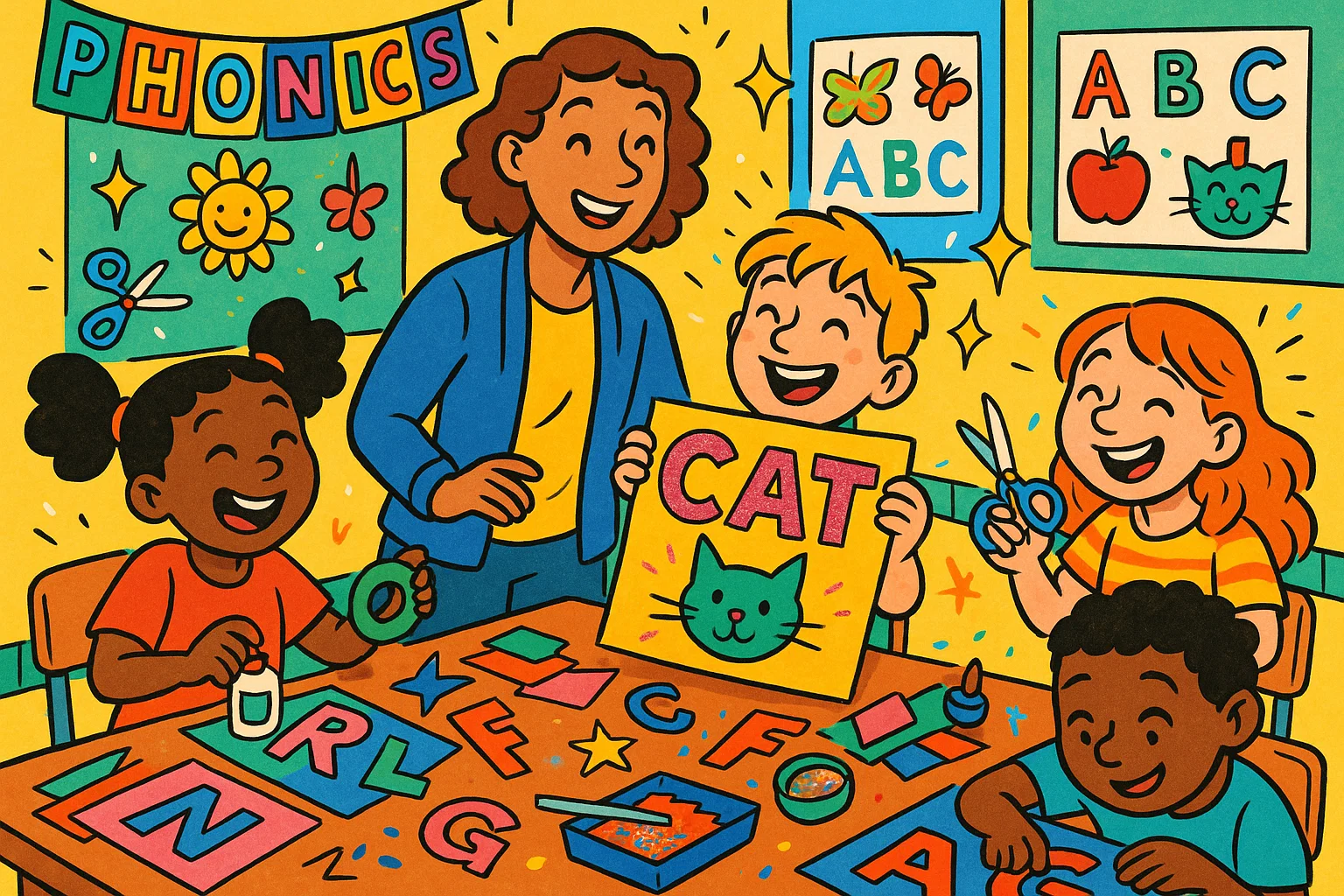
These phonics activities and games enhance the classroom environment and support group learning.
Sing and Move with Phonics Songs
Music and movement activate different parts of the brain, aiding memory.
- Phonics Songs: Integrate educational songs for the alphabet, short vowel sounds, and digraphs (like the “H-Brothers” song). Use hand motions (TPR) to represent the sound—e.g., rubbing hands together for the /sh/ sound—to create a multi-sensory cue.
- Action: Starting literacy lessons with a short phonics song is an effective way to practice a skill quickly and transition students into learning mode.
Anchor Charts for Letter Sounds
These student-created visual aids build collective knowledge and reference points.
- Creation: Dedicate a large sheet of paper to a target sound, like the vowel team ‘ai’.
- Collaboration: As a class, brainstorm words that use the ‘ai’ sound (rain, mail, train). Draw simple pictures and write the word under the visual.
- Result: These charts become permanent, authoritative phonics resources for the students to use independently during read and write tasks.
Phonics Centers and Rotations
Organizing the classroom into specialized phonics centers allows targeted instruction for specific patterns to small groups while others engage in purposeful practice.
| Center Name | Activity Focus | Materials Needed |
| Magnetic Letters Center | CVC word building and segmenting. | Magnetic letters, cookie sheets, set of letter cards. |
| Reading Nook | Read aloud of decodable books with target sounds. | The week’s decodable readers. |
| Tech Hub | Online phonics games for sound review. | Tablets/Computers, headphones. |
| Creation Station | Sticky note matching or sound-sorting craft. | Sticky notes, pictures, glue. |
Word Wall Crafts
Make your Word Wall interactive and meaningful.
- Phonics Flower Garden: Create a “garden” where each vowel team or digraph is a flower, and the words that use that pattern are the petals. Students decorate the petals as they learn the new words, creating a visual, collaborative phonics resource.
Free Phonics Resources and Printables
This site provides accessible phonics instruction. Explore a variety of ready-to-use phonics ideas to support structured learning.
CVC Word Worksheet Pack
This resource focuses exclusively on short vowel sound mastery, which is the important phonics skill for moving into fluency. It includes “circle the correct vowel” and “cut and paste the matching picture” activities.
Weekly Phonics Planner Template
Structure is key for effective phonics instruction. This template helps you organize the introduction of a new letter, practice beginning sounds, review high-frequency words, and schedule a group read and spell session for each week.
Phonics Flashcards and Cutouts
Letter card ideas for classroom creation or home practice for individual letters, digraphs (‘wh’, ‘ph’), and vowel teams (‘ie’, ‘ay’). Print these on cardstock to create durable phonics centers or use as a set of letter cards for fun phonics activities like “Flip the Pancake.”
Tips for Teaching Phonics to Kindergarteners
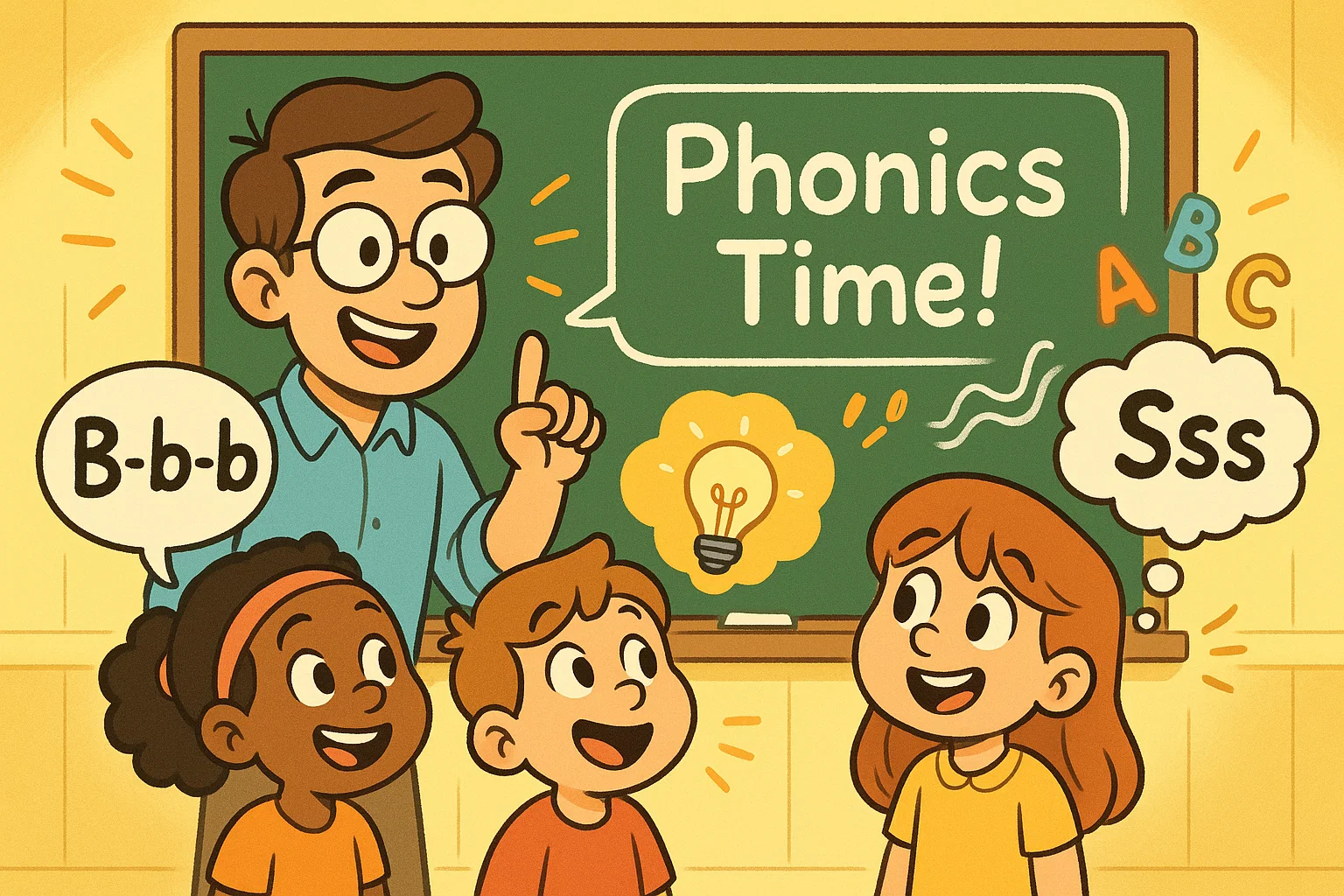
Effective phonics instruction focuses as much on how it’s taught as on what is taught. Follow these guidelines for maximum impact.
Start with Letter Sounds, Then Blends
A systematic, explicit approach is essential for important phonics learning. The progression should be:
- Phonemic Awareness: Playing with sounds without letters (rhyming, clapping syllables).
- Letter-Sound Correspondence: Teaching the sound (e.g., /m/) before the name (e.g., M).
- Blending: Putting sounds together to decode simple CVC words (e.g., mad, sip).
- Complex Patterns: Introducing digraphs, blends, and vowel teams.
This sequence, backed by organizations like the Florida Center for Reading Research, ensures students build solid skills before tackling complex spelling patterns.
Use Repetition and Multi-Sensory Learning
The human brain, particularly a young one, requires multiple exposures to secure a new piece of information. Use repetition and multi-sensory learning across different channels:
- Auditory: Saying the sound aloud (say the letter name).
- Visual: Seeing the letter card and pictures.
- Kinesthetic/Tactile: Building words with magnetic letters or tracing the letter in sand.
This variety is the best way to ensure the concept sticks.
Support English Language Learners
For students still acquiring English, the visual component is critical.
- Use picture-heavy phonics activities like Sound Sorting.
- Increase group reading time to model pronunciation in a safe, collaborative setting.
- When introducing a new letter, use objects or pictures that are universally recognizable to bridge the language gap.
Combine Reading with Phonics Practice
Phonics instruction should never be separate from reading. The final, critical step is applying the phonics skill to real text.
- Action: Immediately follow a vowel team lesson (e.g., on ‘oa’) with a read aloud of a short, decodable book that heavily features ‘oa’ words. Seeing the pattern in context makes the reading process meaningful and reinforces decoding and spelling skills.
Conclusion: Best Ways to Make Phonics Fun for Kindergarten
The journey to literacy is exciting, and prioritizing play and engagement makes phonics principles accessible to every child. The best approach to teach phonics is a systematic one that integrates fun phonics activities with structured phonics practice. By providing a rich environment of hands-on phonics activities, quality phonics resources, and consistent exposure, you empower your child or student to read and write with confidence.
Remember: Consistency is key. A short, fun and engaging 10-minute session with magnetic letters or a Word Walk will yield better results than a long, frustrating lecture.
FAQs about Phonics Activities for Kindergarten
How Often Should Kids Practice Phonics?
Children should engage in dedicated phonics instruction for 10-15 minutes daily. The key is short, consistent exposure, which is much more effective for building strong phonics skill mastery and automaticity than long, sporadic sessions.
What Is the Best Age to Start Phonics?
Formal, systematic phonics instruction, teaching the relationship between letters and sounds, typically begins in kindergarten (age 5-6). However, the foundation, known as phase 1 phonics or phonemic awareness (rhyming, sound blending), should begin much earlier, around age 3–4.
How to Know If My Child Needs More Phonics Support?
Look for difficulties in decoding new words, a struggle to identify beginning sounds in words, or consistent difficulty distinguishing between short vowel sounds. If your child cannot blend a simple CVC word after instruction, they likely need more focused, multi-sensory fun phonics practice.
What Are CVC Words and Why Are They Important?
CVC words (Consonant-Vowel-Consonant), like cat, run, and sip, are the first decodable words students encounter. They are important phonics building blocks because they teach the fundamental skill of blending three sounds together to read the word, which is essential before moving on to complex spelling patterns like digraphs or vowel teams.
